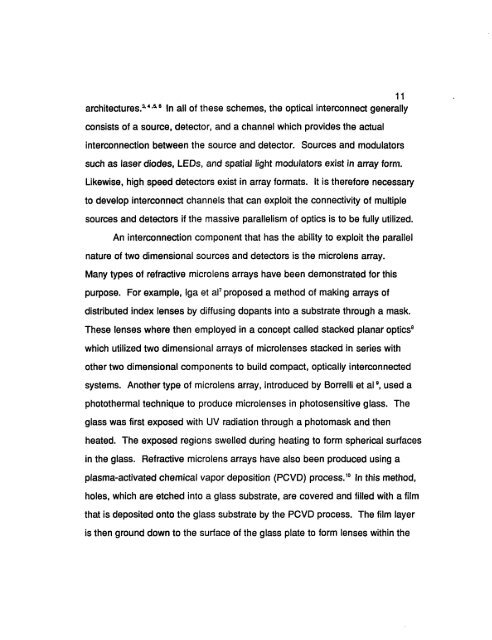azu_td_1349475_sip1_... - Arizona Campus Repository
azu_td_1349475_sip1_... - Arizona Campus Repository
azu_td_1349475_sip1_... - Arizona Campus Repository
You also want an ePaper? Increase the reach of your titles
YUMPU automatically turns print PDFs into web optimized ePapers that Google loves.
11<br />
architectures. 3,4 5 8 In all of these schemes, the optical interconnect generally<br />
consists of a source, detector, and a channel which provides the actual<br />
interconnection between the source and detector. Sources and modulators<br />
such as laser diodes, LEDs, and spatial light modulators exist in array form.<br />
Likewise, high speed detectors exist in array formats. It is therefore necessary<br />
to develop interconnect channels that can exploit the connectivity of multiple<br />
sources and detectors if the massive parallelism of optics is to be fully utilized.<br />
An interconnection component that has the ability to exploit the parallel<br />
nature of two dimensional sources and detectors is the microlens array.<br />
Many types of refractive microlens arrays have been demonstrated for this<br />
purpose. For example, Iga et aP proposed a method of making arrays of<br />
distributed index lenses by diffusing dopants into a substrate through a mask.<br />
These lenses where then employed in a concept called stacked planar optics 8<br />
which utilized two dimensional arrays of microlenses stacked in series with<br />
other two dimensional components to build compact, optically interconnected<br />
systems. Another type of microlens array, introduced by Borrelli et al 9 , used a<br />
photothermal technique to produce microlenses in photosensitive glass. The<br />
glass was first exposed with UV radiation through a photomask and then<br />
heated. The exposed regions swelled during heating to form spherical surfaces<br />
in the glass. Refractive microlens arrays have also been produced using a<br />
plasma-activated chemical vapor deposition (PCVD) process. 10 In this method,<br />
holes, which are etched into a glass substrate, are covered and filled with a film<br />
that is deposited onto the glass substrate by the PCVD process. The film layer<br />
is then ground down to the surface of the glass plate to form lenses within the
















